WayneF
Member
Bob Vogel Shooting Clinic
Date:19-20 Nov 2011
Location: Echo Valley Training Center
I first heard of this course just a couple of weeks prior to it happening. I am very thankful to Shannon, the class host, for getting me in.
The course was held at Echo Valley Training Center. It is a purpose built training facility and offers capabilities that are very hard to find. It is located in High View, WV which is an easy drive from Winchester, VA.
Before I go any further, I should probably touch on my background. I come from a military/LE background and also serve as an adjunct instructor at Practical Firearms Training. My competition experience is limited to State Troopers Association 3 gun matches,a couple of small local handgun matches and shooting on my unit's handgun team.
I knew going into this class that I would be sorely out of my element and that certain things would not relate to me. I also knew that competition shooters present the pinnacle in efficiency of movement, weapons manipulation and a balance of speed and accuracy.
While that is true with most competitive shooters, I knew that with Bob's accomplishments, that it would be taken to a whole other level.
This last year has seen Bob crowned IPSC World Champion (Production), IDPA SSP World Champion (HOA), USPSA Limited 10 National Champion and IDPA Indoor National Champion SSP. Bob is also a full time LEO in Ohio and serves on his department's SRT.
This would prove to be a good mix as the class make up was actually stacked with those that carry guns for a living. While the course was certainly competition oriented, it was obvious that we would pick up new tools to help improve our "game".
The course started out under the shelter at the range where Shannon handled introductions and a safety brief. He then handed control over to Bob so he could start the lecture portion of the class.
We went over the fundamentals which Bob lists as:
1. Trigger Control
2. Sight Alignment
3. Calling the Shot/Follow Through
From there we covered his grip technique which varies a little from the "norm". Instead of worrying about having 360 degrees of the pistol covered and simply running your thumbs forward he prefers to run the support side hand as far forward and as high on the gun as possible. That means giving up a little bit of real estate on the grip of the pistol.
He also using counter opposing inward torque with each hand and locking your arms in such a a way to create as straight a line as possible from the gun to the forearms and back to the shoulders.
He went on to go over the stance, draw, reloads and drills to help work on improving our natural index.
We then kitted up and hit the line. Due to the varying backgrounds present there was quite the wide array of guns and gear present. It ranged from concealed carry gear, LE duty belts, MOLLE war belts with drop leg holsters and full competition rigs.
My gear consisted of a M&P9 with a Surefire X300, Warren Tactical sights, Apex Forward Setting Sear/Trigger and some stippling/shaping of the grip. It was carried in a Peters Custom Holsters Spada on an Ares Gear Ranger Belt. I carried two spare mags on my support side and one behind the pistol for single hand manipulations (not needed) and to backfill my other pouch.
After some warm ups at 25 yards we moved in and picked up the pace until we were running Bill Drills at about the 7 yard line. After working on paper a bit just to see where we were at we transitioned over to steel. Rob Tackett from TacStrike brought out enough of his quarter scale steel targets and arched paper target stands that we could run the drills in one firing order.
Using the steel meant we had instant feedback and didn't have to spend time repairing targets between strings.
Bob had us a do several drills that consisted of multiple hits on a single target and then transitions between multiple targets on a single plane and then varying distances.
A heavy emphasis was placed on trying to close the gap in our transition times with a goal of getting them to as close to our splits as possible.
We then moved back to the plate rack which Bob uses slightly different than most folks. Instead of simply clearing the plate rack, you were given 30 seconds to deliver as many hits as possible on the six plates and two steel targets set off to the side.
We then moved some of the paper targets over to use as barricades and repeated the drill while incorporating movement between each and firing around either side and under cover.
The second day had us performing some more warm up drills. We then ran some drills incorporating dice which would tell us what targets to shoot or not shoot. We then started to run stages under the watchful eye of Bob after watching him run it. This is when I really became aware of how much of a thinking man's game practical shooting competitions really are. To be able to land a decent time you had to not only combine the raw shooting and weapons manipulation skills but also mentally plan out each and every step of the stage first.
It was amazing to see the degree of planning Bob puts into each and every stage. What looks like a great shooter simply running around shooting things is really a well choreographed plan, down to each and every step.
Each stage was set up to force us to adapt more and more layers and problems to solve. Problems such as low ports, hard leans around cover, shooting on the move, partially obscured targets and high round counts meant each stage got progressively more difficult.
The day was then finished off with a little friendly competition on the dueling tree and some final thoughts from Bob.
Firing from ports of varying height meant everyone had a chance to see if they were better off taking a knee or squatting:
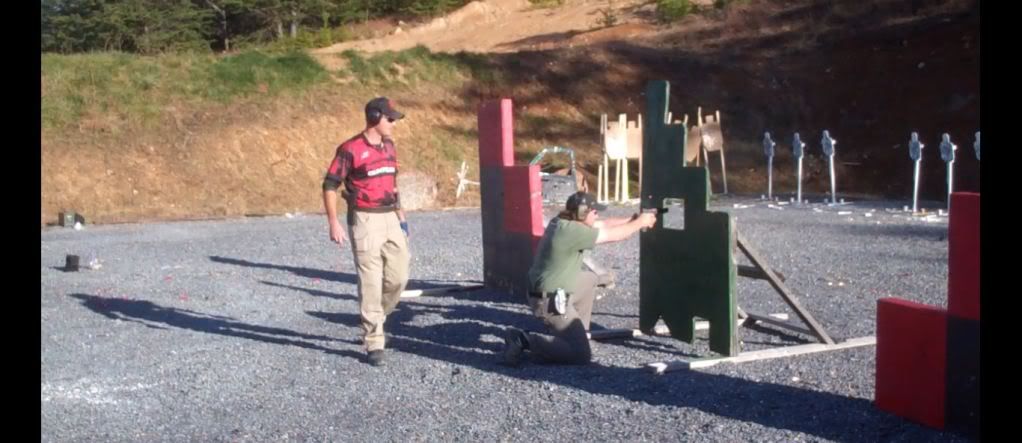
Using paper targets in the portable TacStrike stands as barricades, Bob combined shooting on the move along with using your peripheral vision to navigate:

Bob teaches trying to get the pistol down on the deck and keeping your arms lock to keep recoil to a minimum allowing for quicker follow up shots:

Keeping the fault lines in tight meant having to make some aggressive leans on some shots:
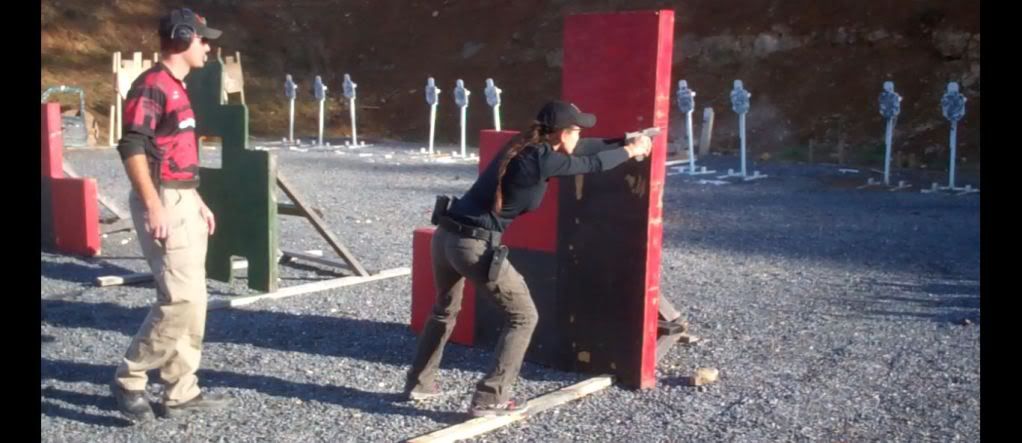
Running multiple hits on up to a dozen targets meant ammo management had to be kept in mind during stages:
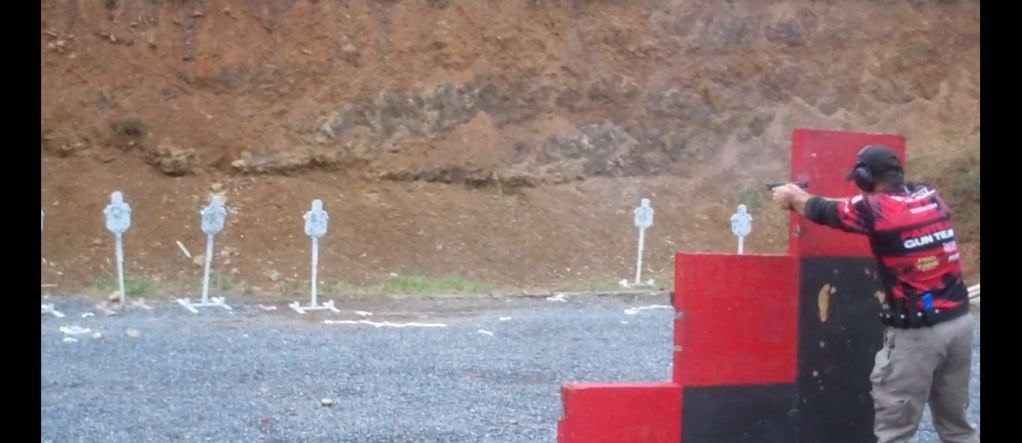
Movement varied between just a few steps to several yards, many incorporating shooting on the move:
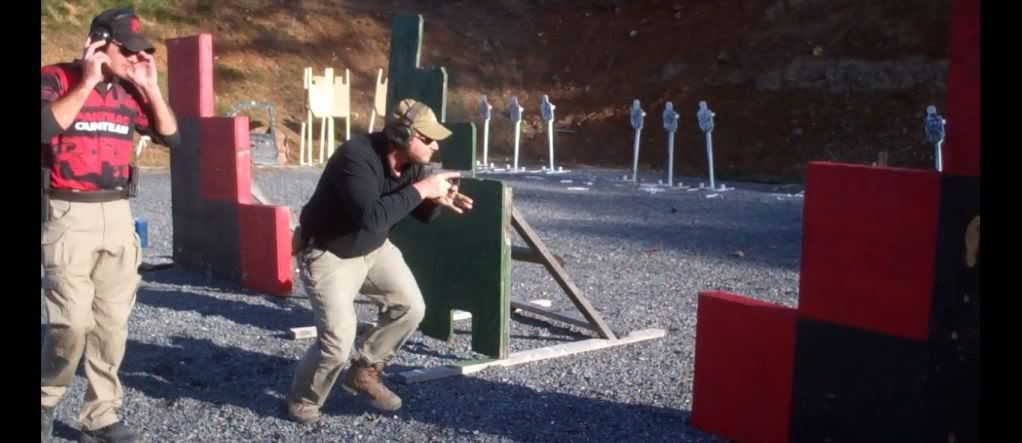
With multiple targets and short distances meant you had to reload quickly and get back on target while on the move:
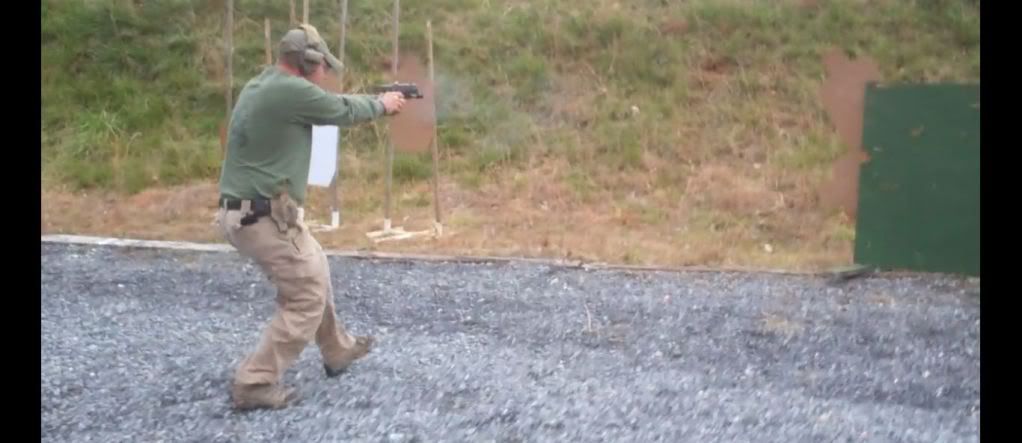 [/quote]
[/quote]
Date:19-20 Nov 2011
Location: Echo Valley Training Center
I first heard of this course just a couple of weeks prior to it happening. I am very thankful to Shannon, the class host, for getting me in.
The course was held at Echo Valley Training Center. It is a purpose built training facility and offers capabilities that are very hard to find. It is located in High View, WV which is an easy drive from Winchester, VA.
Before I go any further, I should probably touch on my background. I come from a military/LE background and also serve as an adjunct instructor at Practical Firearms Training. My competition experience is limited to State Troopers Association 3 gun matches,a couple of small local handgun matches and shooting on my unit's handgun team.
I knew going into this class that I would be sorely out of my element and that certain things would not relate to me. I also knew that competition shooters present the pinnacle in efficiency of movement, weapons manipulation and a balance of speed and accuracy.
While that is true with most competitive shooters, I knew that with Bob's accomplishments, that it would be taken to a whole other level.
This last year has seen Bob crowned IPSC World Champion (Production), IDPA SSP World Champion (HOA), USPSA Limited 10 National Champion and IDPA Indoor National Champion SSP. Bob is also a full time LEO in Ohio and serves on his department's SRT.
This would prove to be a good mix as the class make up was actually stacked with those that carry guns for a living. While the course was certainly competition oriented, it was obvious that we would pick up new tools to help improve our "game".
The course started out under the shelter at the range where Shannon handled introductions and a safety brief. He then handed control over to Bob so he could start the lecture portion of the class.
We went over the fundamentals which Bob lists as:
1. Trigger Control
2. Sight Alignment
3. Calling the Shot/Follow Through
From there we covered his grip technique which varies a little from the "norm". Instead of worrying about having 360 degrees of the pistol covered and simply running your thumbs forward he prefers to run the support side hand as far forward and as high on the gun as possible. That means giving up a little bit of real estate on the grip of the pistol.
He also using counter opposing inward torque with each hand and locking your arms in such a a way to create as straight a line as possible from the gun to the forearms and back to the shoulders.
He went on to go over the stance, draw, reloads and drills to help work on improving our natural index.
We then kitted up and hit the line. Due to the varying backgrounds present there was quite the wide array of guns and gear present. It ranged from concealed carry gear, LE duty belts, MOLLE war belts with drop leg holsters and full competition rigs.
My gear consisted of a M&P9 with a Surefire X300, Warren Tactical sights, Apex Forward Setting Sear/Trigger and some stippling/shaping of the grip. It was carried in a Peters Custom Holsters Spada on an Ares Gear Ranger Belt. I carried two spare mags on my support side and one behind the pistol for single hand manipulations (not needed) and to backfill my other pouch.
After some warm ups at 25 yards we moved in and picked up the pace until we were running Bill Drills at about the 7 yard line. After working on paper a bit just to see where we were at we transitioned over to steel. Rob Tackett from TacStrike brought out enough of his quarter scale steel targets and arched paper target stands that we could run the drills in one firing order.
Using the steel meant we had instant feedback and didn't have to spend time repairing targets between strings.
Bob had us a do several drills that consisted of multiple hits on a single target and then transitions between multiple targets on a single plane and then varying distances.
A heavy emphasis was placed on trying to close the gap in our transition times with a goal of getting them to as close to our splits as possible.
We then moved back to the plate rack which Bob uses slightly different than most folks. Instead of simply clearing the plate rack, you were given 30 seconds to deliver as many hits as possible on the six plates and two steel targets set off to the side.
We then moved some of the paper targets over to use as barricades and repeated the drill while incorporating movement between each and firing around either side and under cover.
The second day had us performing some more warm up drills. We then ran some drills incorporating dice which would tell us what targets to shoot or not shoot. We then started to run stages under the watchful eye of Bob after watching him run it. This is when I really became aware of how much of a thinking man's game practical shooting competitions really are. To be able to land a decent time you had to not only combine the raw shooting and weapons manipulation skills but also mentally plan out each and every step of the stage first.
It was amazing to see the degree of planning Bob puts into each and every stage. What looks like a great shooter simply running around shooting things is really a well choreographed plan, down to each and every step.
Each stage was set up to force us to adapt more and more layers and problems to solve. Problems such as low ports, hard leans around cover, shooting on the move, partially obscured targets and high round counts meant each stage got progressively more difficult.
The day was then finished off with a little friendly competition on the dueling tree and some final thoughts from Bob.
Firing from ports of varying height meant everyone had a chance to see if they were better off taking a knee or squatting:

Using paper targets in the portable TacStrike stands as barricades, Bob combined shooting on the move along with using your peripheral vision to navigate:

Bob teaches trying to get the pistol down on the deck and keeping your arms lock to keep recoil to a minimum allowing for quicker follow up shots:

Keeping the fault lines in tight meant having to make some aggressive leans on some shots:

Running multiple hits on up to a dozen targets meant ammo management had to be kept in mind during stages:

Movement varied between just a few steps to several yards, many incorporating shooting on the move:

With multiple targets and short distances meant you had to reload quickly and get back on target while on the move:










